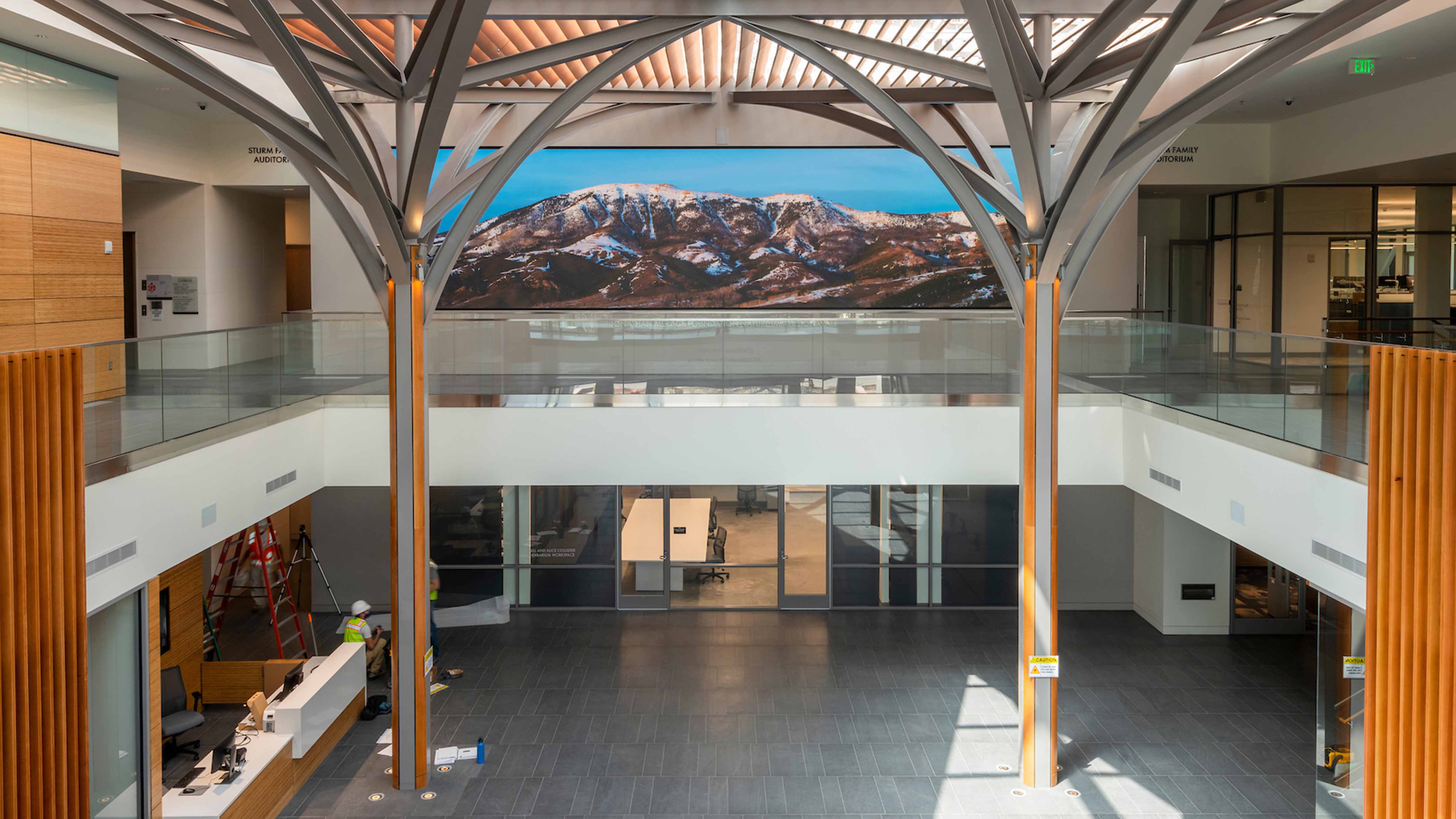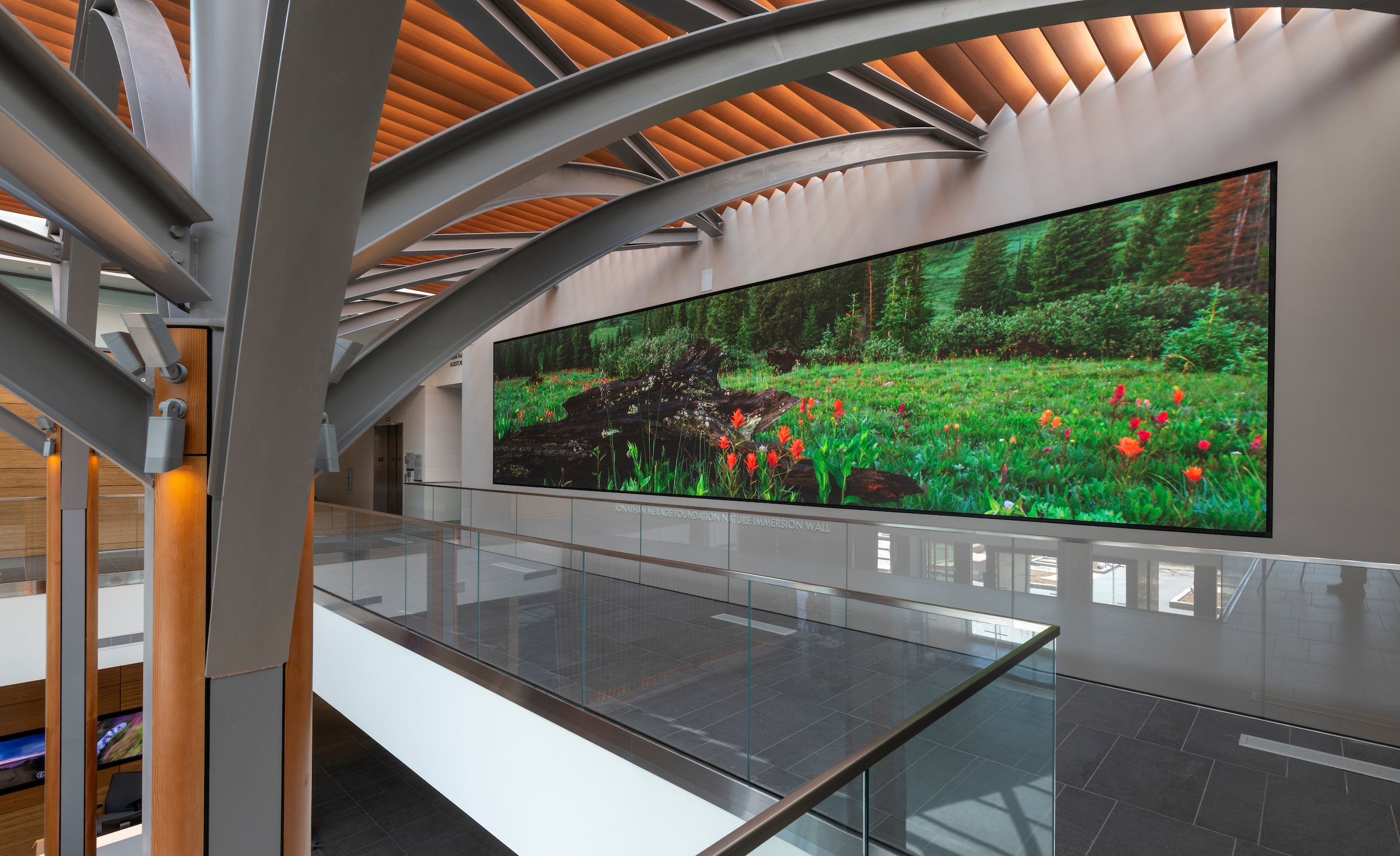Natural Connections
A new video wall at Denver Botanic Gardens highlights the region's diverse ecosystem.

On display at Denver Botanic Gardens, a 23-acre public garden in Denver, is a living plant collection, natural history collection, and art exhibitions. With the mission of converging science, art, and education, its new Freyer-Newman Center is home to an auditorium, library, herbarium, research labs, art galleries, and classrooms. Now, as part of a comprehensive master development plan, the building has a modern way to connect visitors with nature.
Located in the second-floor foyer of the atrium space and flanked by galleries is a recessed video wall, which was designed to engage visitors with educational videos and original content featuring the diverse ecosystems found in the state of Colorado. The 40x10-foot Absen LED video wall, which features a 1.8mm pixel pitch, is driven by an RGB Spectrum Galileo video processor. The systems were designed by BCER, an MEP engineering, technology, and life safety consultancy headquartered in Arvada, CO, and installed by E2 Optics LLC, a local AV integration firm. The Freyer-Newman Center was designed by Denver's Davis Partnership Architects and built by GH Phipps Construction, which is headquartered in Greenwood Village, CO.
Immersive Experience
“The video wall is part of the architectural design of the building—it dominates your view and makes you feel like you’re connected with nature, even though you’re indoors,” explained Dan Domagala, director of innovation and technology at Denver Botanic Gardens. The exhibits in the adjacent galleries are almost always plant and nature-focused, he added, with the video wall creating a connection between the two.

The content for this display, as well as for other smaller screens throughout the facility, is entirely original, captured and produced by a team of videographers and documentarians that work for the Gardens’ in-house production studio, Denver Botanic Films. “It’s designed to be an immersive experience that highlights the different flora and fauna around the state,” Domagala said.
Content is regularly updated to keep things fresh for return visitors. “Right now we have about 50 different scenes and we’ll rotate them—we’ll plug in new ones and remove others to make it an ongoing experience," he noted. The Gardens is also planning to use the video wall for digital art installations.
Delivering real-time throughput and 4K image quality, RGB Spectrum’s Galileo receives videos and still images via computer feeds. Randy Nozawa, CTS, audio visual designer at BCER, said his firm collaborated with the Gardens, Absen, and RGB Spectrum when discussing the display’s video processing requirements. The main driver behind selecting the Galileo was the content that the Gardens would be displaying.
A daily selection of the top stories for AV integrators, resellers and consultants. Sign up below.

“There are a lot of moving, high-resolution images that they want to show to create that living space,” he explained. “An important part of the selection process involved [determining] what the frame rates were, the resolution of moving content that can be pushed, and how it’s distributed.”
According to Nozawa, content is arguably the most important factor in large-scale digital signage design. “What is your client going to show on that video wall, and is it going to fit on something that giant? If it’s a bunch of lists—like class roster information or something like that—it may not be as functional as you’d like,” he offered.
Electrical Considerations
The space itself also influences design choices. “This space is a large atrium that’s full of daylight—all day, every day—which really limits the feasibility of utilizing a projection system," he added. "We need to have that direct-view LED to provide that brightness so [the images are] visible at all hours of the day.”
[Explore Faraway Lands…in Atlanta]
Designers and integrators must also take structural and electrical engineering considerations into account when deploying large-scale displays. Nozawa said the video wall at Denver Botanic Gardens weighs approximately 1,800 pounds and requires 14 dedicated 20-amp circuits to power it. Calculating heat loads is also crucial to ensure the smooth operation of the systems over time. Nozawa said it was critical to coordinate with their "mechanical counterparts" during the design process.

“This is a recessed video wall, so there were considerations we needed to take into account to make sure that there was adequate airflow and venting for the wall, so that it can distribute all its heat out and it doesn’t cook those panels,” he explained. "There were a lot of discussions about what the content was going to be, and how long it was going to be on, to help mechanical decide what they needed to support.”
Domagala confirmed that coordination between his facility, the architect, and the AV designer and integrator was essential in order for this project to succeed. “It’s a centerpiece showcase that was intentionally designed as part of the building, so that includes not only the placement, but all the back-end electronics and power in order to make all this happen,” he said. “It required a lot of coordination between not only the architect but also the builder, because we need that wall as flat as possible; there are hundreds of video panels that are all side-by-side, and if there are any buckles the seams are going to really be noticeable.”
[Suspended LED Ceiling Brings Outside In at the Indianapolis Museum of Art]
Nozawa, whose firm has recently specified similar large-scale display systems for other projects in the state, said that a growing number of facilities are deploying large-scale video walls as showpieces. He believes that this trend exists, in part, because technology costs are decreasing, but also because venues are experimenting with how to use technology to augment the architectural experience in their spaces.
“One of the cool things about this particular install and some of the others we’re doing—like the Anschutz campus at the University of Colorado—is it’s really using technology as a supplement to the space,” he said. “It’s intended to enhance the beauty of the space and provide a kind of ambient feeling. And I think it’s really cool to have technology included as part of what that space means, and not be the only focus of what that space is.”
Content Still Reigns
Randy Nozawa, CTS, audio visual designer at BCER, noted that one of the challenges in working with clients who request digital signage displays is planning for content. “For any digital signage system, there is sometimes a disconnect between having digital signage and what you’re going to put on digital signage—and the owner is not always aware of that gap,” Nozawa observed.
This wasn’t an issue at Denver Botanic Gardens, since the facility has its own in-house production studio, Denver Botanic Films. However, for clients that might not have those capabilities, BCER (which doesn’t offer content creation services) has formed relationships with specialized agencies who can assist clients with content creation and management.
Engineering Priorities
Darren Smith, senior director of specialty divisions at AV integrator E2 Optics, said his team starts the digital signage deployment process by conferring with the client on their concept and budget. They will then provide suggestions on how the client may enhance the experience they wish to achieve, as well as extend the lifecycle of the system.
“We lean towards using proven technology, and when we need to go ‘cutting edge,’ we never deploy without significant beta testing of the product in the most extreme environments that the system will experience,” Smith explained. “Engineering is the top priority. We never guess—it is all by the numbers provided [on] heat, power, and structural detail to ensure the overall project is successful.”
Carolyn Heinze has covered everything from AV/IT and business to cowboys and cowgirls ... and the horses they love. She was the Paris contributing editor for the pan-European site Running in Heels, providing news and views on fashion, culture, and the arts for her column, “France in Your Pants.” She has also contributed critiques of foreign cinema and French politics for the politico-literary site, The New Vulgate.
